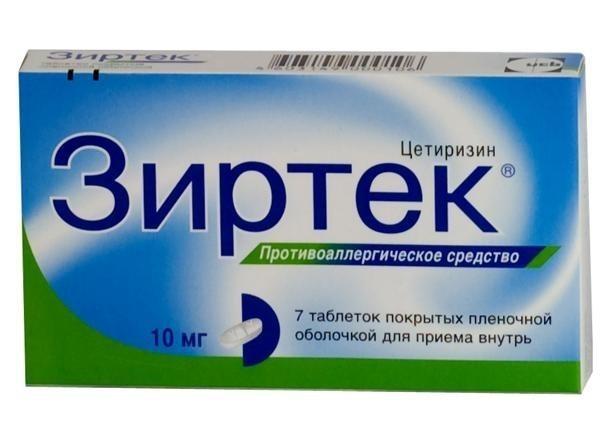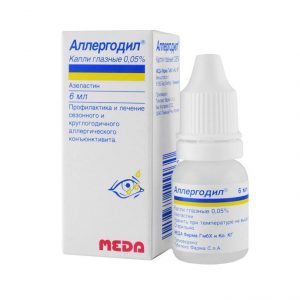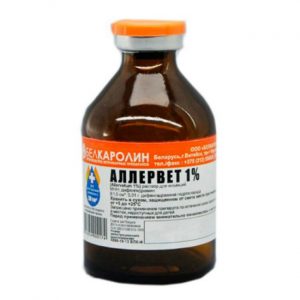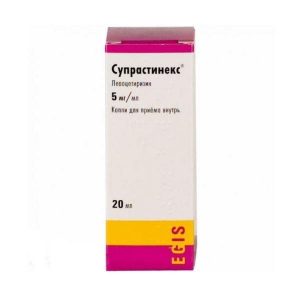Description
Release form
Coated tablets.
Packing
7 pcs.
Pharmacological action of
Zyrtec is a selective antagonist of peripheral histamine H1 receptors, a metabolite of hydroxyzine. It has an antiallergic effect, inhibiting the late phase of migration of cells involved in the inflammatory reaction (mainly eosinophils) also reduces the expression of adhesion molecules such as ICAM-1 and VCAM-1, which are markers of allergic inflammation. It inhibits the action of other mediators and inducers of histamine secretion, such as PAF (platelet-activating factor) and substance R.
Zyrtec suppresses skin reactions in patients with cold urticaria and dermographism. When using the drug in a dose of 5 to 10 mg in patients with mild asthma, the development of bronchospasm caused by a high concentration of histamine administered as an aerosol was almost completely blocked.
A six-week study in 168 patients with allergic rhinitis in combination with mild to moderate bronchial asthma demonstrated the effectiveness of cetirizine at a dose of 10 mg for rhinitis and showed the safety of cetirizine in patients with allergic rhinitis and mild to moderate bronchial asthma.
Prescribing cetirizine in doses exceeding 6 times the daily therapeutic dose (60 mg / day), and placebo as a control for 7 days, did not reveal prolongation of the QT interval on the ECG.
The action of the drug begins 20 minutes after a single dose of 10 mg in a single dose in 50% of patients and after 1 h in 95% of patients, and tolerance to its antihistamine effect is not observed for 24 hours. The skin restores its normal reactivity to histamine 3 days after discontinuation of the drug.
The use of Zyrtec in therapeutic doses of 10 mg / day improved the quality of life of patients with year-round and seasonal allergic rhinitis.
Indications
For adults and children 1 year of age and older treatment of symptoms: – year-round and seasonal allergic rhinitis and allergic conjunctivitis, such as pruritus, sneezing, rhinorrhea, lacrimation, hyperemia conjunctiva
– hay fever (hay fever)
– urticaria (including chronic idiopathic urticaria) and Quincke edema
– other allergic dermatoses accompanied by itching and rashes.
Contraindications
Hypersensitivity to the drug or hydroxyzine.
Use during pregnancy and lactation
It is preferable to refrain from using Zyrtek during pregnancy.
Since cetirizine is excreted in breast milk, if you need to prescribe the drug during lactation, you should decide whether to stop breastfeeding.
In experimental studies, the teratogenic or embryotoxic effect of the drug was not established.
Special instructions
When used in recommended doses, Zyrtec does not enhance the effect of alcohol (when its content in the blood is up to 0.5 g / l), nevertheless, it is recommended to refrain from drinking alcohol while using Zyrtek.
Influence on the ability to drive vehicles and control mechanisms
Objective methods for studying the ability to engage in potentially hazardous activities did not reliably reveal any adverse effects when using the drug at a recommended dose of 10 mg.
Composition
1 tablet contains cetirizine hydrochloride 10 mg
excipients: MCC silicon lactose dioxide colloidal magnesium stearate hypromellose titanium macrogol dioxide 400 (polyethylene glycol).
Side effects
From the digestive system: dry mouth in some cases – dyspepsia.
From the side of the central nervous system: mild and rapidly passing drowsiness, headache, fatigue in some cases are possible – agitation.
Allergic reactions: in some cases, skin rashes, angioedema.
The drug is generally well tolerated. Side effects are rare, usually have a weak and transient character.
Storage conditions
Tablets should be stored in a dry place at a temperature below 25 ° C.
Terms and conditions
without prescription
dosage form
tablets
Indications
Allerhycheskyy conjunctivitis, Allerhyya, Allerhycheskyy rynyt, neurodermatitis, edema Kvynke, Pollynoz, dermatitis, Dyatez, Kozhn y itching, dermatitis, atopic dermatitis, Krapyvnytsa




